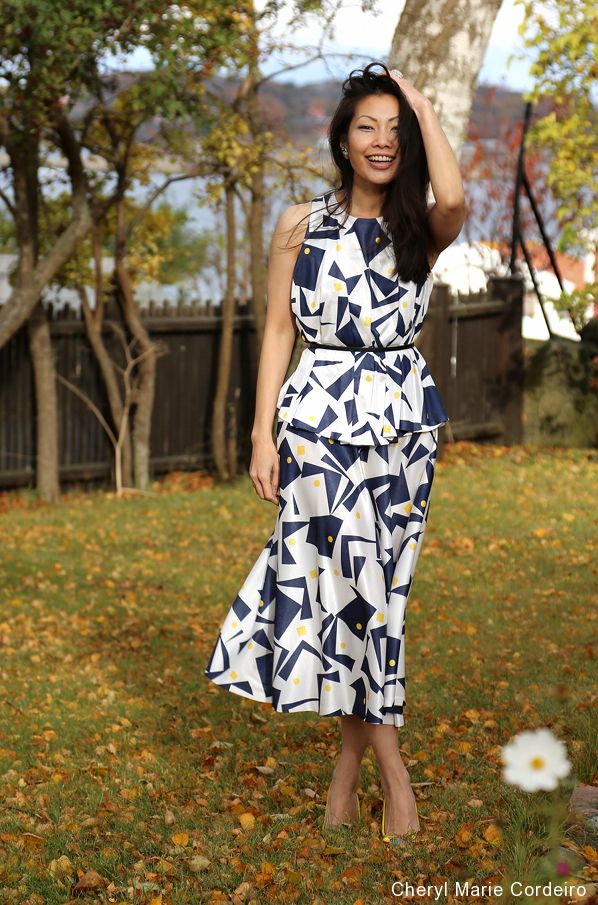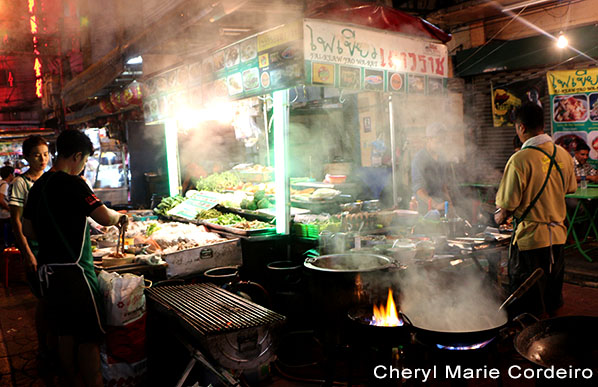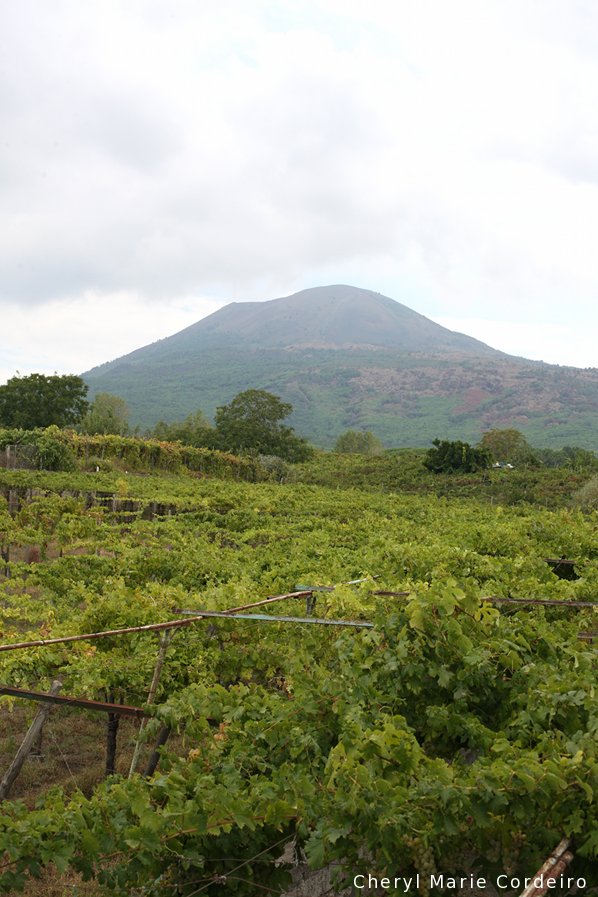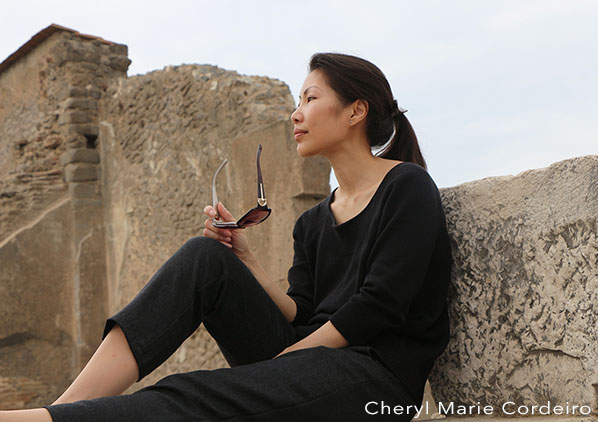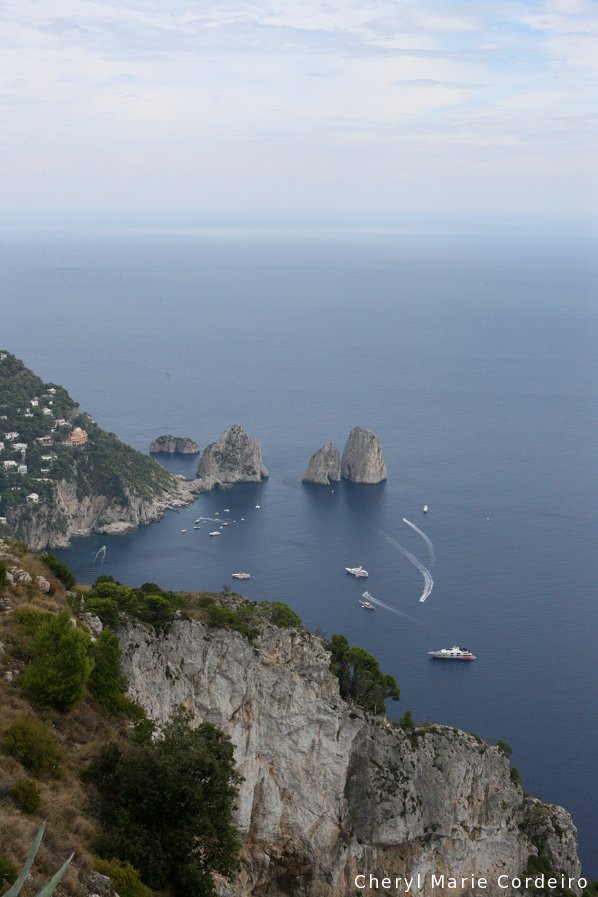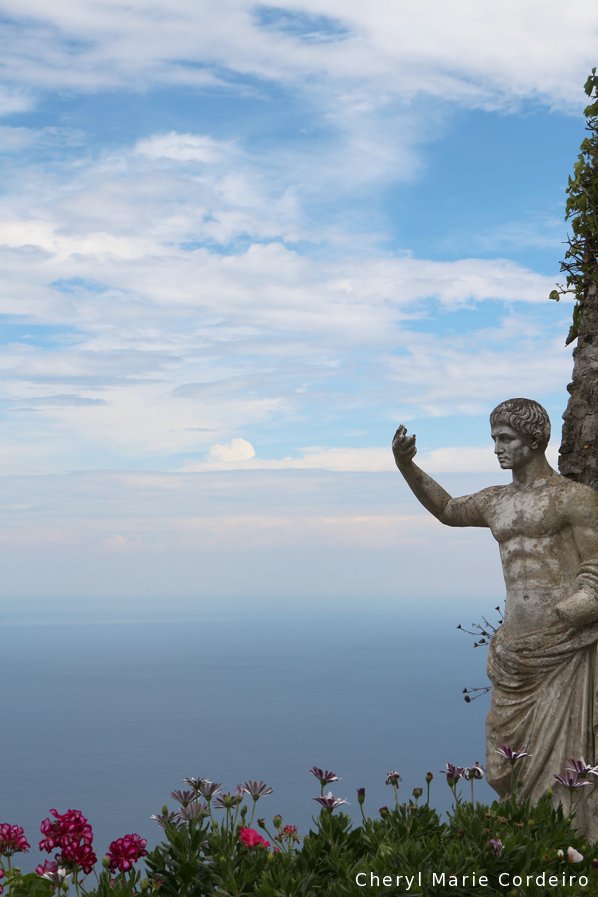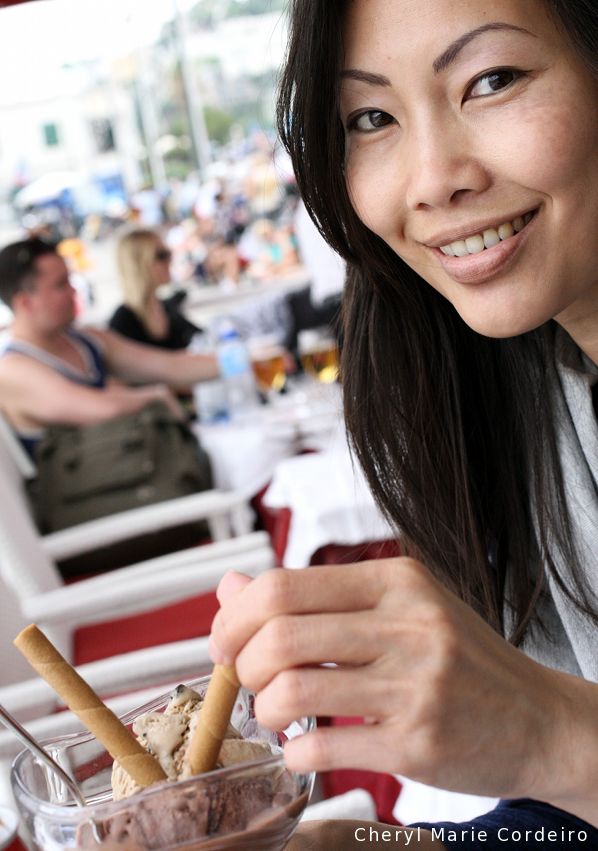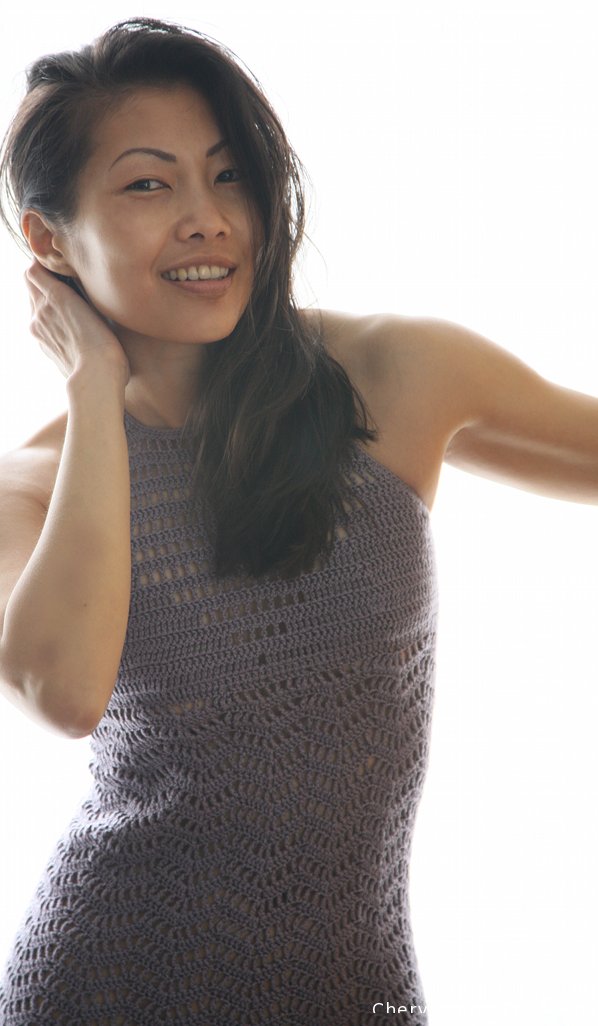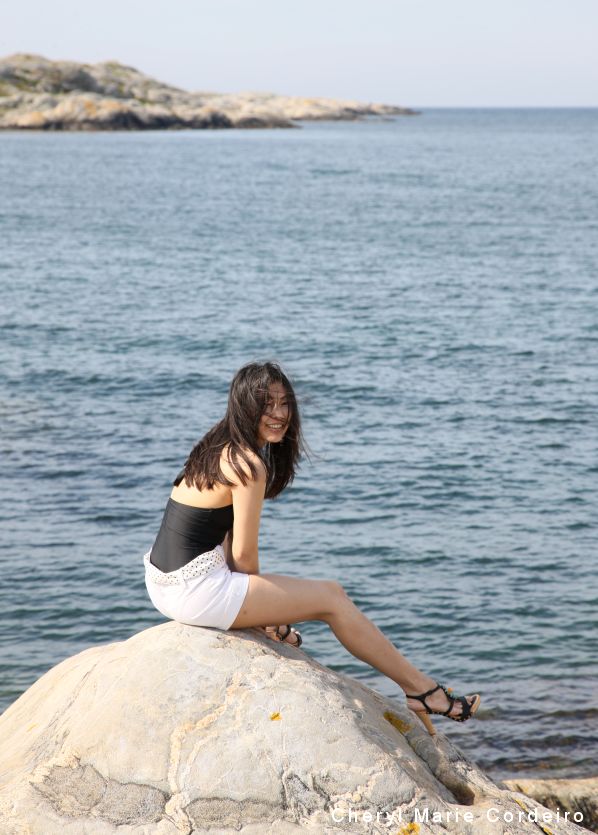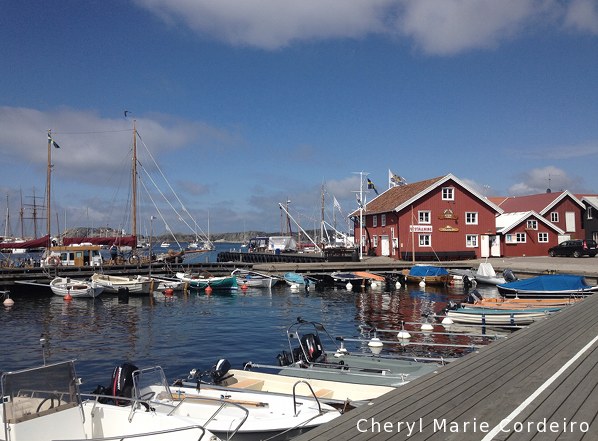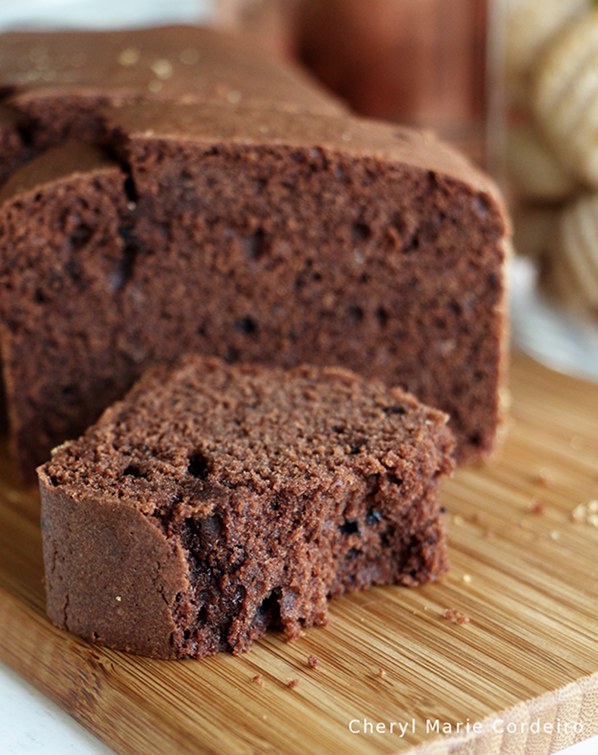In a vintage Tricosa dress, 1970s, Paris, made in France.
Text & Photo © JE Nilsson, CM Cordeiro, Sweden 2016
Street food, Bangkok, Thailand 2016
Chinatown at after five, Bangkok, Thailand.
Text & Photo © JE Nilsson, CM Cordeiro, Sweden 2016
I had not often come across a decline in request to a destination, especially one in which tourists are encouraged to visit, but the tuk-tuk driver absolutely declined to drop us off at Chinatown in mid-morning in Bangkok, Thailand. “There is nothing there to see now. After five p.m. okay. But if you really want to go, I can drop you off at the corner 7-11 shop and you can walk from there.” He spoke to us through the rear view mirror of the tuk-tuk, his eyes meeting ours. After some contemplation, I asked, “Where would you recommend we go now? What is open?” His eyes lit up with a smile, “I bring you river tour! But first, I bring you to tailor shop? Very good suits for you, Sir!” He had already brought us to two other tailor shops, plus a jewellery outlet. So we kindly agreed to the river tour, but we didn’t want any more tailor visits. It was our turn to decline. “Only five minutes!” he intervened, “Very fast! You just go in spend five minutes, and then I get free petrol. Free petrol. You help me?” he said, unabashedly, with a big smile. He was already off to his designated shop. I turned to look at Sir and said, “I’ll probably find another cheongsam to tailor with Thai silk.” Continue reading “Street food, Bangkok, Thailand 2016”
On the slopes of Mount Vesuvius
A commanding view that belongs to Mount Vesuvius.
Text & Photo © JE Nilsson, CM Cordeiro, Sweden 2016
Lush, with a hint of aridity in the air, is what I would describe the climate that surrounds the undulating lands around Mount Vesuvius just about this time of year. That, and a certain solemnity and silence that blankets the surroundings. But this solemnity is permeating, because I have felt this sense of quiet even in the heart of the city of Naples when walking along the Gulf of Naples. We walk around the vineyard with our guide who knows the grounds well. The landscape reminds me somewhat of the landscape found in southeastern France.
It was about lunch hour when we strolled about the grounds where we were introduced to the various grape varieties planted, as well as other friendly vegetables complementing. Walking with a few steps between us in distance, our guide suddenly turned to us and said, “You know, I’m training running”, with a nod in the direction of Vesuvius. Continue reading “On the slopes of Mount Vesuvius”
Pompeii, Campania, Italy 2016
At the Forum, the central area in the ancient ruins of the city of Pompeii, Campania, Italy 2016.
Text & Photo © JE Nilsson, CM Cordeiro, Sweden 2016
I developed an interest in archaeology as a hobby read from when I was about fourteen years old. Having read about Pompeii, and followed its archaeological uncoverings through my teenage years since the early 1990s, I visit this UNESCO World Heritage site in 2016 with mixed feelings.
Located across the Bay from the city of Naples in southern Italy, you seem never allowed to lose your bearing to Mount Vesuvius. Gaping at the top where in ancient paintings it was once capped, Vesuvius dominates the horizon. It stands in statement of the events that took place in 79 AD. As a reminder of its last large outbreak in 1944, it is still 95 centigrade warm a few meters under the ground. That is a hair’s breath from boiling. But for now, on the surface, the fire mountain slumbers.
The region around Vesuvius today hosts some three million inhabitants that would need to be evacuated immediately when, not if, Vesuvius wakes up again. Inhabiting the area could possibly be human optimism, else, more pragmatically, the fertile soils of the land afforded by the very fire mountain itself gives the possibility of good trade (thus good living), especially in wine. Continue reading “Pompeii, Campania, Italy 2016”
Postcards from Capri, Naples, Italy
Capri, Gulf of Naples, Italy 2016. View towards the Amalfi coast from Monte Solaro.
Text & Photo © JE Nilsson, CM Cordeiro, Sweden 2016
Gelato, gelato, gelato
Bar Corallo, Capri, Italy 2016.
Text & Photo © JE Nilsson, CM Cordeiro, Sweden 2016
Just a few days prior to landing in southern Italy, I walked out of a little gelateria, Gelato Da Luca, in Gothenburg, Sweden. Newly located in the heart of Gothenburg’s older marketing district where cobbled streets were set out in grid format, I had in hand from this gelateria, a paper cup of two generous scoops of Italian made ice-cream. Caffè and cioccolato fondente (extra dark chocolate).
I could always do gelato, the sequence being caffè and cioccolato fondente, then cioccolato fondente and pistacchio. If there was no caffè or pistacchio, then it will be nocciola. I was only too happy to know that the owner, who had come to Sweden from Rome, had decided to open a second outlet in Gothenburg, both outlets being equidistant to the Business School at the University of Gothenburg.
Already then, I had decided that when in southern Italy, or Italy at all, I would gelato.
And that, I did. That, and cioccolata calda, a smooth, thick hot chocolate concoction that rivals Granja M. Viader xocolata calenta in Barcelona, Spain.
Swapping different types of cobbled stones from Gothenburg to southern Italy, I was beyond delighted to once again, gelato. Continue reading “Gelato, gelato, gelato”
Stream of consciousness: An evolution
In a crochet halterneck T-back dress made by my mother, Rita Yong Cordeiro.
The dress was made in mid-1990s.
Text & Photo © JE Nilsson, CM Cordeiro, Sweden 2016
For as long as I can remember, my mother crocheted. Well, yes. She had made her own wedding dress a whole two years before I was born. Thing is, having handcrafted frills of dresses since baby in arm, I never really thought about the rarity of the skill of the producer or rarity of product/s as such. That I had access to these time-consuming handcrafted clothing made by my working mother from the time of my Christening till when I graduated with a doctoral degree was something I had quite taken for granted.
I read in Richard Feynman’s 1985 self-biography [1] that whilst at MIT, he had to take mandatory humanities courses, of which one of them was philosophy. He got deathly bored during philosophy classes that having happened to be in possession of a small drill, about one-sixteenth-inch, he made holes in the soles of his shoes by twisting this tool into the sole of his shoes, week after week. Continue reading “Stream of consciousness: An evolution”
Styrsö Sandvik, 2016
Styrsö Sandvik guest harbour [1], Sweden, summer 2016.
Text & Photo © JE Nilsson, CM Cordeiro, Sweden 2016
Styrsö Sandvik was one of the best sandy beaches that the old summer resort Styrsö ever had in the 19th century. But landscapes evolve and eventually, modern times caught up with even this small part of the world when the local fishing fleet decided they needed a current and better protected harbour. So it was that the long sandy beach so much appreciated by the locals as well as the city slanker* (as they were called at the time by the locals in local dialect), were no more.
Now in the current millennium the tide is turning again and the tourist, service and “experience” industry is reclaiming territory. The novelty and charm of harbours such as this for visitors for the moment is to get to experience first hand, island life and island living. Docked in this harbour are larger fishing boats, and in neat piles by dockside are lobster and crab nets for when it is season.
The fish harbour shares its space as guest harbour for pleasure yachts complete with harbour café, neat bathing facilities, a children’s playground and a barbecue pit for the occasional older children who might want spare ribs and a beer. Continue reading “Styrsö Sandvik, 2016”
Skärhamn – A Swedish west coast fishing village in the 21st century, Sweden 2016
Flying into Sweden on an aerial view before landing, I continue to marvel at how green the country is. More green than I have ever seen before even if I was born in equatorial tropical rainforest region, this Scandinavian landscape far north of the globe has its green interspersed with water fills of varying dimensions. The first few years of my being here which is now more than a decade ago, I thought nothing much of it. There was nothing to see, just green. Today, the sight of the Nordic tree tops interspersed with water, as far as the eye takes you, is a treasured moment of aerial encounter. And contrary to my initial impression, there is a lot to see.
Skärhamn, Tjörn, Sweden, summer 2016.
Text & Photo © JE Nilsson, CM Cordeiro, Sweden 2016
Most of Sweden is very scenic. The panoramic terrains from Skåne in the South of Sweden to Lappland, way north of the arctic circle, is distinct and different.
The west coast of Sweden is the country’s own riviera. Besides facing the North Sea and the Atlantic, it is kept warmer than the rest of Sweden by the Gulf Stream that passes just outside its coast. The west coast goes from long sandy beaches in the South until you hit the old Viking territories, around Gothenburg. From there and up north, the terrain becomes rocky and the coast is cut into hundreds of large and small islands, separated by steep cliffs and deep fjords.
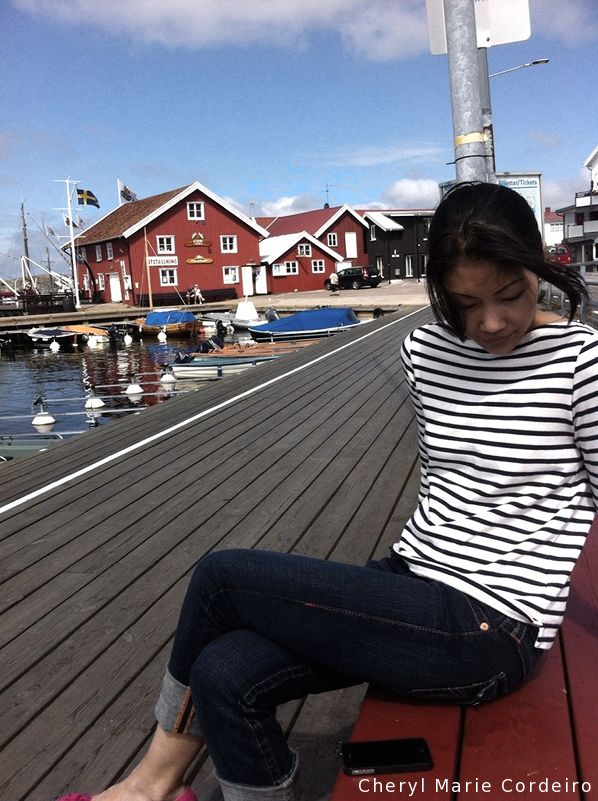 Continue reading “Skärhamn – A Swedish west coast fishing village in the 21st century, Sweden 2016”
Continue reading “Skärhamn – A Swedish west coast fishing village in the 21st century, Sweden 2016”
Chocolate in seasons
A chocolate cake based on a brownie recipe.
Text & Photo © JE Nilsson, CM Cordeiro, Sweden 2016
Foods are seasonal. There was a time when growing up in Singapore, I would have prawn noodle soup everyday after school hours at the hawker centre at the bus terminal. The bus terminal was the interval stop between the Convent where I went to school (located in walking proximity to the Singapore’s east coast beach), and the government built housing apartment farther inland north-east, that was home. Prior to hopping on to a loop feeder bus service, I would drop my school bag and files on a stool at a table at the hawker centre and go order lunch. There were at least five different variations of this dish you could order. After a year or so, the owners of the stall knew me by name and knew my order. I only had to wave and smile in their direction and they would come with a bowl of prawn noodles with the type of noodles I preferred. The prawn noodle soup season lasted three years, after which it never seemed to ever come back in season for me. Last I had a bowl of prawn noodle soup that was in season in the manner I preferred was more than twenty eight years ago.
Chocolate however, seems to be in season all year round, and has been so for more than thirty five years. I remember a photograph of me from when I was age seven or eight living in the east of Singapore. I had a broad grin with a mouthful of melted chocolate. It must’ve been chocolate cake I was eating at someone’s birthday, because that was the only time we had such decadent cakes filled with buttercream between and over layers of sponge cakes. Continue reading “Chocolate in seasons”
